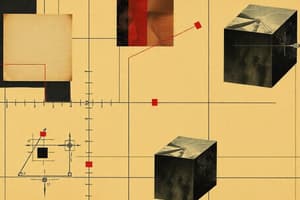Podcast
Questions and Answers
What is the cube of the number 7?
What is the cube of the number 7?
- 256
- 729
- 512
- 343 (correct)
Which of the following numbers has a square of 196?
Which of the following numbers has a square of 196?
- 15
- 16
- 14 (correct)
- 19
What is the sum of the square of 12 and the cube of 3?
What is the sum of the square of 12 and the cube of 3?
- 189 (correct)
- 1728
- 144
- 1896
Which number's cube is equal to 1728?
Which number's cube is equal to 1728?
If the square of a number is 81, what is the number?
If the square of a number is 81, what is the number?
What is the sum of the square of 15 and the cube of 4?
What is the sum of the square of 15 and the cube of 4?
Which of the following numbers has a square greater than 300 but less than 400?
Which of the following numbers has a square greater than 300 but less than 400?
Which number has a cube of 729?
Which number has a cube of 729?
If the cube of a number is 512, what is the number?
If the cube of a number is 512, what is the number?
What is the difference between the square of 14 and the cube of 5?
What is the difference between the square of 14 and the cube of 5?
Flashcards are hidden until you start studying
Study Notes
Table of Powers
- The table displays squares and cubes of numbers 1 through 20.
- The table is organized systematically, with each row corresponding to a different number.
- The first column shows the number, the second column displays the square of that number, and the third column displays the cube of that number.
- The squares of numbers are calculated by multiplying the number by itself.
- The cube of a number is calculated by multiplying the number by itself three times.
- For example, the square of 5 is 25 (5 x 5 = 25), and the cube of 5 is 125 (5 x 5 x 5 = 125).
- The table shows that the values increase rapidly as the numbers increase.
- The table appears to have data beyond what's shown, but the rest of the information is truncated.
- It suggests that the data will continue the pattern of numbers, squares, and cubes.
Table of Powers
- The table shows squares and cubes of numbers from 1 to 20
- The table is organized by number, with square and cube values listed in the corresponding columns
- The values in the table are calculated by raising the number in the first column to the power of 2 (square) or 3 (cube)
- The table appears to be missing information on the calculation of powers greater than 3
- The table highlights the systematic relationship between the power of a number and its resulting value
- The table aids in the understanding of various power calculations of numbers
- The table can be used as a reference for those who need to calculate squares and cubes
Studying That Suits You
Use AI to generate personalized quizzes and flashcards to suit your learning preferences.




